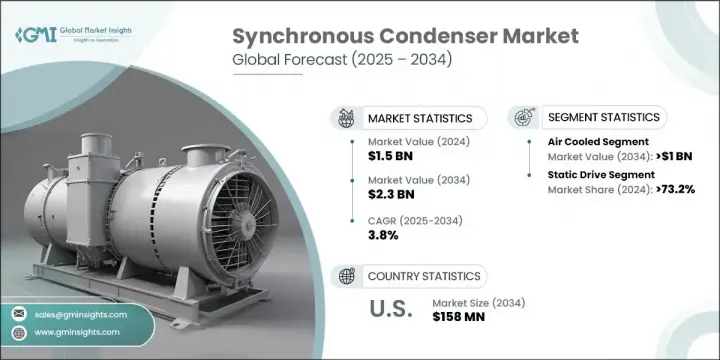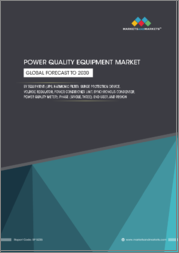
|
시장보고서
상품코드
1801887
동기 진상기 시장 기회, 성장 촉진요인, 산업 동향 분석 및 예측(2025-2034년)Synchronous Condenser Market Opportunity, Growth Drivers, Industry Trend Analysis, and Forecast 2025 - 2034 |
||||||
동기 진상기 세계 시장 규모는 2024년에 15억 달러로 평가되었고, CAGR 3.8%로 성장하여 2034년에는 23억 달러에 이를 것으로 예측됩니다.
이 시장의 성장을 주도하는 것은 전 세계 재생 에너지 통합의 가속화, 전력망 신뢰성에 대한 우려 증가, 전력 인프라의 일관된 업그레이드입니다. 동기 진상기는 종종 동기 진상기라고 불리며, 무효 전력 지원, 전압 제어, 역률 보정 등의 중요한 기능을 제공하는 회전 기계입니다. 이러한 장치는 특히 출력 변동이 심한 태양광과 풍력 발전이 계속 확대되는 상황에서 송전망의 안정성을 유지하는 데 매우 중요한 역할을 하고 있습니다. 또한, 안정적이고 반응성이 높은 전력 제어가 필수적인 구식 전력망 시스템 현대화의 일환으로 널리 채택되고 있습니다. 세계 전력 수요 증가와 에너지 투자 급증에 따라 효율적인 무효전력 보상 기술에 대한 요구가 빠르게 증가하고 있습니다.

공냉식 동기 진상기 부문은 2034년까지 10억 달러에 달할 것으로 예측됩니다. 심플한 디자인, 비용 효율성, 최소한의 인프라 요구 사항으로 물 공급이 제한된 지역이나 안전 규정 준수가 까다로운 지역에 적합합니다. 또한, 기술의 발전으로 성능과 신뢰성이 향상되어 다양한 전력 시스템 환경에서 활용이 확대되고 있습니다.
| 시장 범위 | |
|---|---|
| 개시 연도 | 2024년 |
| 예측 연도 | 2025-2034년 |
| 개시 금액 | 15억 달러 |
| 예측 금액 | 23억 달러 |
| CAGR | 3.8% |
정적 드라이브 부문은 2024년 73.2%의 점유율을 차지했으며, 2034년까지 연평균 복합 성장률(CAGR) 3%로 성장할 것으로 전망됩니다. 이 드라이브는 IGBT 및 사이리스터와 같은 최신 파워 일렉트로닉스를 이용하여 토크와 시동 전류를 정확하게 제어합니다. 기존 포니 모터와 달리 정적 드라이브는 기계적 복잡성을 줄이고, 유지보수 수고를 줄이며, 장비의 수명을 연장합니다. 장기적인 운영 효율을 높일 수 있기 때문에 대규모 그리드 용도에 매력적인 솔루션입니다.
미국 동기 진상기 시장은 2034년까지 1억 5,800만 달러에 달할 것으로 예측됩니다. 에너지 안보와 전력망 현대화에 초점을 맞춘 연방 정부의 정책은 첨단 무효전력 솔루션의 채택을 촉진하고 있습니다. 석유, 가스 등 산업 부문의 에너지 수요 증가도 이러한 추세에 박차를 가하고 있습니다. 미국은 전 세계 청정에너지 투자의 15%를 담당하고 있으며, 화석에너지와 재생에너지 부문 모두에서 중심적인 역할을 담당하고 있습니다.
세계 동기 진상기 시장을 형성하고 있는 주요 기업으로는 Hitachi, Siemens Energy, Eaton, ABB, General Electric 등이 있습니다. 동기 진상기 시장의 주요 기업들이 채택하고 있는 주요 전략은 시스템 효율성과 지속가능성을 높이기 위한 R&D 투자 확대, 특히 공랭식 구동 기술 및 고정식 구동 기술에 대한 투자 확대입니다. 각 업체들은 제품 포트폴리오를 확장하고, 세계 입지를 넓히기 위해 합병, 제휴, 인수합병을 시도하고 있습니다. 제조업체는 진화하는 규제 기준을 충족하기 위해 SF6가 없는 친환경 유닛 개발에 주력하고 있습니다. 또한, 고객에게 전체 라이프사이클의 가치를 제공하기 위해 예지보전 솔루션, 장기 운전 지원 등 서비스 지향적 모델을 전개하고 있습니다. 계통 운영자 및 유틸리티 사업자와의 협력은 경쟁 우위를 확보하는 데 있어 여전히 핵심적인 역할을 하고 있습니다.
목차
제1장 조사 방법과 범위
제2장 주요 요약
제3장 산업 인사이트
- 생태계 분석
- 원료 가용성 상황
- 밸류체인에 영향을 미치는 요인
- 파괴적 변화
- 규제 상황
- 산업에 대한 영향요인
- 성장 촉진요인
- 산업 잠재적 리스크와 과제
- 성장 가능성 분석
- Porter의 Five Forces 분석
- 공급 기업의 교섭력
- 바이어의 교섭력
- 신규 진출업체의 위협
- 대체품의 위협
- PESTEL 분석
- 새로운 기회와 동향
- 투자 분석과 전망
제4장 경쟁 구도
- 서론
- 지역별 기업의 시장 점유율
- 북미
- 유럽
- 아시아태평양
- 중동 및 아프리카
- 라틴아메리카
- 전략적 이니셔티브
- 경쟁 벤치마킹 묘사
- 전략 대시보드
- 혁신과 기술 상황
제5장 시장 규모와 예측 : 냉각별, 2021-2034년
- 주요 동향
- 수소 냉각
- 공랭식
- 수냉식
제6장 시장 규모와 예측 : 시동 방법별, 2021-2034년
- 주요 동향
- 스태틱 드라이브
- 포니 모터
- 기타
제7장 시장 규모와 예측 : 최종 용도별, 2021-2034년
- 주요 동향
- 유틸리티
- 산업
제8장 시장 규모와 예측 : 무효 정격 출력별, 2021-2034년
- 주요 동향
- 100 MVAr 이하
- 10-200MVar
- 200 MVAr 이상
제9장 시장 규모와 예측 : 지역별, 2021-2034년
- 주요 동향
- 북미
- 미국
- 캐나다
- 멕시코
- 유럽
- 독일
- 이탈리아
- 프랑스
- 러시아
- 아시아태평양
- 중국
- 인도
- 일본
- 호주
- 한국
- 중동 및 아프리카
- 사우디아라비아
- 아랍에미리트(UAE)
- 남아프리카공화국
- 라틴아메리카
- 브라질
- 아르헨티나
제10장 기업 개요
- ABB
- Alstom SA
- ANDRITZ
- Ansaldo Energia
- Baker Hughes
- Bharat Heavy Electricals Limited
- BRUSH
- Doosan
- Eaton
- General Electric
- Hitachi Energy Ltd.
- Ingeteam
- Mitsubishi Electric Power Products, Inc.
- NIDEC Corporation
- Power Systems & Controls, Inc.
- Shanghai Electric
- Siemens Energy
- Toshiba Energy Systems & Solutions Corporation
- Voith GmbH & Co.
- WEG
The Global Synchronous Condenser Market was valued at USD 1.5 billion in 2024 and is estimated to grow at a CAGR of 3.8% to reach USD 2.3 billion by 2034. Growth in this market is being driven by the worldwide acceleration of renewable energy integration, growing concerns over grid reliability, and consistent upgrades in power infrastructure. Synchronous condensers, often referred to as synchronous capacitors, are rotating machines that deliver essential functions like reactive power support, voltage control, and power factor correction. These devices play a pivotal role in maintaining grid stability, especially as solar and wind energy-known for their variable output-continue to expand. They are also being adopted widely as part of the modernization of outdated grid systems, where stable and responsive power control is essential. With global electricity demand rising and energy investments surging, the need for efficient reactive power compensation technologies is increasing rapidly.

The air-cooled synchronous condensers segment is expected to reach USD 1 billion by 2034. Their simple design, cost-efficiency, and minimal infrastructure requirements make them ideal for areas with limited water supply or strict safety compliance. Technological advancements have also improved their performance and dependability, expanding their usage across diverse power system environments.
| Market Scope | |
|---|---|
| Start Year | 2024 |
| Forecast Year | 2025-2034 |
| Start Value | $1.5 Billion |
| Forecast Value | $2.3 Billion |
| CAGR | 3.8% |
The static drives segment held a 73.2% share in 2024 and is forecasted to grow at a CAGR of 3% through 2034. These drives utilize modern power electronics like IGBTs and thyristors to ensure accurate control of torque and startup currents. Unlike traditional pony motors, static drives offer reduced mechanical complexity, require less maintenance, and extend the life of equipment. Their ability to enhance long-term operational efficiency makes them an attractive solution for large-scale grid applications.
United States Synchronous Condenser Market will reach USD 158 million by 2034. Federal policies focused on energy security and grid modernization are encouraging the adoption of advanced reactive power solutions. The increasing energy demand from industrial sectors such as oil and gas also adds to this momentum. With the U.S. responsible for 15% of global clean energy investment, it remains a central player in both fossil and renewable energy sectors, reinforcing its strong role in the global synchronous condenser market.
The top companies shaping this Global Synchronous Condenser Market include Hitachi, Siemens Energy, Eaton, ABB, and General Electric. Key strategies adopted by major players in the synchronous condenser market include expanding R&D investments to enhance system efficiency and sustainability, especially in air-cooled and static drive technologies. Companies are targeting mergers, partnerships, and acquisitions to broaden their product portfolios and increase their global footprint. Manufacturers are focusing on the development of SF6-free, environmentally friendly units to meet evolving regulatory standards. Additionally, service-oriented models such as predictive maintenance solutions and long-term operational support are being rolled out to provide customers with full lifecycle value. Collaborations with grid operators and utilities remain central to gaining competitive advantage.
Table of Contents
Chapter 1 Methodology & Scope
- 1.1 Research design
- 1.2 Market estimates & forecast parameters
- 1.3 Forecast calculation
- 1.4 Data sources
- 1.4.1 Primary
- 1.4.2 Secondary
- 1.4.2.1 Paid
- 1.4.2.2 Public
Chapter 2 Executive Summary
- 2.1 Industry synopsis, 2021 - 2034
Chapter 3 Industry Insights
- 3.1 Industry ecosystem analysis
- 3.1.1 Raw material availability landscape
- 3.1.2 Factors affecting the value chain
- 3.1.3 Disruptions
- 3.2 Regulatory landscape
- 3.3 Industry impact forces
- 3.3.1 Growth drivers
- 3.3.2 Industry pitfalls & challenges
- 3.4 Growth potential analysis
- 3.5 Porter's analysis
- 3.5.1 Bargaining power of suppliers
- 3.5.2 Bargaining power of buyers
- 3.5.3 Threat of new entrants
- 3.5.4 Threat of substitutes
- 3.6 PESTEL analysis
- 3.6.1 Political factors
- 3.6.2 Economic factors
- 3.6.3 Social factors
- 3.6.4 Technological factors
- 3.6.5 Legal factors
- 3.6.6 Environmental factors
- 3.7 Emerging opportunities & trends
- 3.8 Investment analysis & future outlook
Chapter 4 Competitive Landscape, 2025
- 4.1 Introduction
- 4.2 Company market share, by region, 2024
- 4.2.1 North America
- 4.2.2 Europe
- 4.2.3 Asia Pacific
- 4.2.4 Middle East & Africa
- 4.2.5 Latin America
- 4.3 Strategic initiatives
- 4.4 Competitive benchmarking depictions
- 4.5 Strategy dashboard
- 4.6 Innovation & technology landscape
Chapter 5 Market Size and Forecast, By Cooling, 2021 - 2034 (USD Million)
- 5.1 Key trends
- 5.2 Hydrogen Cooled
- 5.3 Air Cooled
- 5.4 Water Cooled
Chapter 6 Market Size and Forecast, By Starting Method, 2021 - 2034 (USD Million)
- 6.1 Key trends
- 6.2 Static Drive
- 6.3 Pony motors
- 6.4 Others
Chapter 7 Market Size and Forecast, By End Use, 2021 - 2034 (USD Million)
- 7.1 Key trends
- 7.2 Utility
- 7.3 Industrial
Chapter 8 Market Size and Forecast, By Reactive Power Rating, 2021 - 2034 (USD Million)
- 8.1 Key trends
- 8.2 ≤ 100 MVAr
- 8.3 > 100 MVAr to ≤ 200 MVAr
- 8.4 > 200 MVAr
Chapter 9 Market Size and Forecast, By Region, 2021 - 2034 (USD Million)
- 9.1 Key trends
- 9.2 North America
- 9.2.1 U.S.
- 9.2.2 Canada
- 9.2.3 Mexico
- 9.3 Europe
- 9.3.1 Germany
- 9.3.2 Italy
- 9.3.3 France
- 9.3.4 Russia
- 9.4 Asia Pacific
- 9.4.1 China
- 9.4.2 India
- 9.4.3 Japan
- 9.4.4 Australia
- 9.4.5 South Korea
- 9.5 Middle East & Africa
- 9.5.1 Saudi Arabia
- 9.5.2 UAE
- 9.5.3 South Africa
- 9.6 Latin America
- 9.6.1 Brazil
- 9.6.2 Argentina
Chapter 10 Company Profiles
- 10.1 ABB
- 10.2 Alstom SA
- 10.3 ANDRITZ
- 10.4 Ansaldo Energia
- 10.5 Baker Hughes
- 10.6 Bharat Heavy Electricals Limited
- 10.7 BRUSH
- 10.8 Doosan
- 10.9 Eaton
- 10.10 General Electric
- 10.11 Hitachi Energy Ltd.
- 10.12 Ingeteam
- 10.13 Mitsubishi Electric Power Products, Inc.
- 10.14 NIDEC Corporation
- 10.15 Power Systems & Controls, Inc.
- 10.16 Shanghai Electric
- 10.17 Siemens Energy
- 10.18 Toshiba Energy Systems & Solutions Corporation
- 10.19 Voith GmbH & Co.
- 10.20 WEG



















